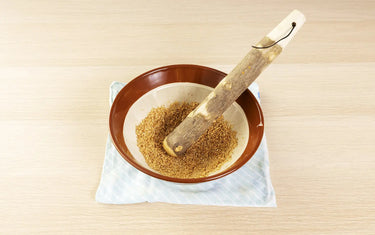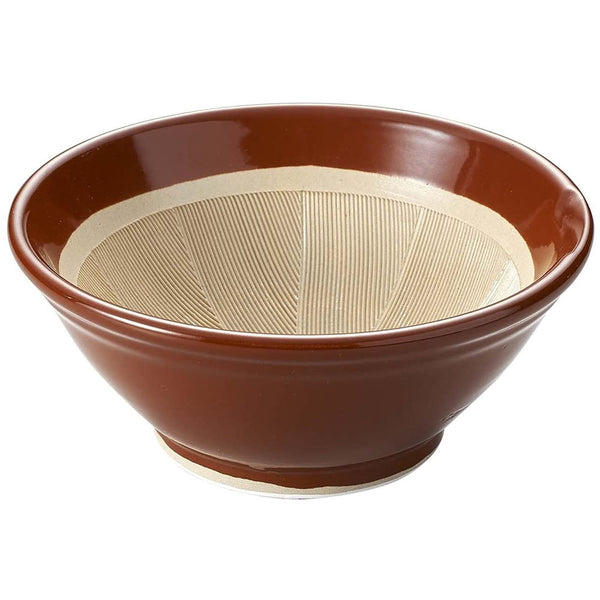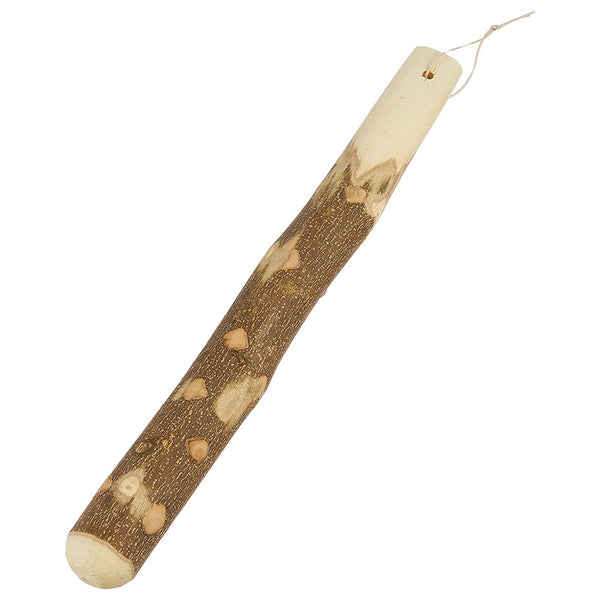The products we used:
The Perfect Family Meal
Close your eyes and try to imagine the perfect family meal. What would it look like? For a typical Japanese family, it might look like:
- A platter or two of okonomiyaki, topped with mayo, okonomi-sauce, kombu and aonori. Macho Papa adds some hot sauce.
- Sesame seed dressing for Cutie Mama's salad.
- Baby food for Little Ms. Nose Bubbles.
- Guacamole--a traditional Japanese adult baby food dating back to the early 90s--as an okonomiyaki dip (look it up). Crazy Son and Artistic Daughter fight over the guac and spill it on the floor.
- Macha for Kimono Baba and Jinbei Jiji to sip on peacefully after the meal.
At the center of the Perfect Family Meal is the Yamase Tokoname Ware Suribachi Mortar, the king of mashing, smashing, grinding, and mixing.
What are suribachi and what food can you make with them?

"Suribachi" is the Japanese word for mortar. Mortar are culinary tools used for grinding and mixing food, and are typically made of ceramics. Mortar are typically parred with a special stick called a pestle (or "surikogi" in Japanese). The mortars and pestles typically used in Japan have two key features:
- Mortar have radial grooves on the inside. The rough ceramic surface is protected by a glassy glaze, preventing stains.
- Pestles are made of wood and have a rounded end to provide ample grip and surface area for grinding and mixing.
Together, they can be used to make the Perfect Family Meal.
- Ground sesame is often used to make dressings and sauces. Those dressings and sauces are often mixed directly in the mortar after grinding the sesame seeds.
- Ground yamaimo is a common ingredient in okonomiyaki, or savor Japanese pancakes. Yamaimo are quite slimy, but the mortar and pestle's rough surfaces are able to grip the yamaimo without any trouble.
- Baby food.
- Guacamole--basically baby food for adults.
- Macha powder.
But that's not all. Using a Yamase Tokoname Ware Suribachi Mortar, the world of Japanese cuisine is at your fingertips.
- Grate wasabi root for your next sushi party.
- Mash umeboshi to make umeboshi paste.
- Grind sansho peppers into powder for use in tempura or on grilled meat.
- Smash tofu because it had it coming.
Choosing the right size mortar and pestle

When you're considering buying a mortar, you may be puzzled by the various sizes available. At Globalkitchen Japan, we offer ten different sizes of mortars from Yamase, from 19cm to a whopping 58cm. Which one is suitable for you?
Generally, if you're cooking for 1-2 people, the 19cm will do fine. For 3-4 people, the 22-25cm models will work well. If your husband is especially handsome and successful, you may have a few extra kids yelling, "When's dinner gonna be ready, Cutie Mama? I'm starving!" In that case, you may need a 28 or 31cm model. 33-37cm is appropriate for a small group of preschoolers and the 40-46cm models are perfect for party prep.
The 58cm is typically reserved for making an example of the Bad Child so that your other children eat their vegetables.
As for the pestle, you'll want one that's twice as tall as your mortar. In a pinch, if you're using the 58cm mortar, you can use your old highschool baseball bat.
How to Use a Mortar and Pestle

So you pulled the trigger, closed the Amazon.com tabs (I know you peeked), and ordered a Yamase Tokoname Ware Suribachi Mortar from Globalkitchen Japan (arigatogozaimasu!), now what?
If you're new to grinding food using rough surfaces and sticks, let me guide you with the help of my Cutie Wife. For this demonstration, she ground up some sesame seeds.
1. Place a wet cloth under the mortar

The wet cloth helps prevent the mortar for spinning around your counter top. You can substitute any other non-slip surface you, like a silicon mat.
2. Place an appropriate amount of food in the mortar

Don't overfill or you're going to have a bad time and your dog is going to have wasabi in his fur.
3. Grip and Grind

Use both hands to grip the pestle. One hand should hold the top end, the other hand should hold the pestle underneath the top hand. The top hand is for stabilizing the pestle and shouldn't move too much. Use your lower hand to rotate the pestle around the mortar to grind, mix, and mash the food.
4. Wipe Drool Off Your Mouth and Serve
My Cutie Wife enjoyed the smell of the freshly ground sesame seeds and worked up a heafy appetite.
The good news is that she was able to take the mortar straight to the table and serve it as-is. Looks like earth, smells like home, tastes like heaven.
Maintaining Your Mortar Yamase Tokoname Ware Suribachi Mortar

To ensure that your Yamase Tokoname Ware Suribachi Mortar serves you well for a long time, proper care is essential.
Cleaning Your Yamase Tokoname Ware Suribachi Mortar and Pestle
After use, fill the suribachi with water or hot water to soften any residue, then wash it with a sponge or similar cleaning tool. For stubborn oil stains, you can use kitchen detergent.
When cleaning the grooves, it's recommended to use a tawashi brush or a toothbrush. Avoid using a metal scrubber as it may damage the glaze and surface.
Bamboo scrubbers, known for cleaning woks in Chinese cuisine, are also useful for mortar maintenance. However, be sure to take care of them after use to prevent mold growth. Alternatively, you can use toothpicks as an alternative to bamboo scrubbers. Bundle several toothpicks together with a rubber band to mimic the action of a bamboo scrubber. Toothpick bundles are disposable, ensuring cleanliness with each use.
Maintaining Your Pestle
Wooden pestle sticks tend to absorb moisture, so it's advisable to moisten the surface with water before use. This prevents food from penetrating the stick. After use, soak it in water to soften any residue. Prolonged immersion in water can lead to black mold growth and cracking, so exercise caution.
After washing off any residue with a soft sponge, ensure thorough drying. When drying, place it horizontally to allow proper air circulation. Avoid vertical placement, as this may trap moisture inside the stick. Adequate ventilation is essential. Avoid sun-drying, as it can cause cracking.
Dealing with Black Mold on Your Mortar
If you find black mold on your mortar, fill it with water and use kitchen chlorine bleach. Once you've removed the black mold, make sure to rinse it thoroughly.
If black mold has developed on your pestle stick, start by wetting the surface and washing it with a neutral detergent. If that doesn't work, try sanding the moldy area on the dry stick with sandpaper. If the mold problem persists, it may have penetrated deep inside the stick, and in such cases, consider replacing it with a new one.
Heavenly Japanese Cuisine Awaits You

The Perfect Family Meal is so close you can smell it, Dear Reader. What are you waiting for? The 19cm model is only seven bucks for crying out loud. Pick up a Yamase Tokoname Ware Suribachi Mortar from Globalkitchen Japan now. It's a no brainer.















